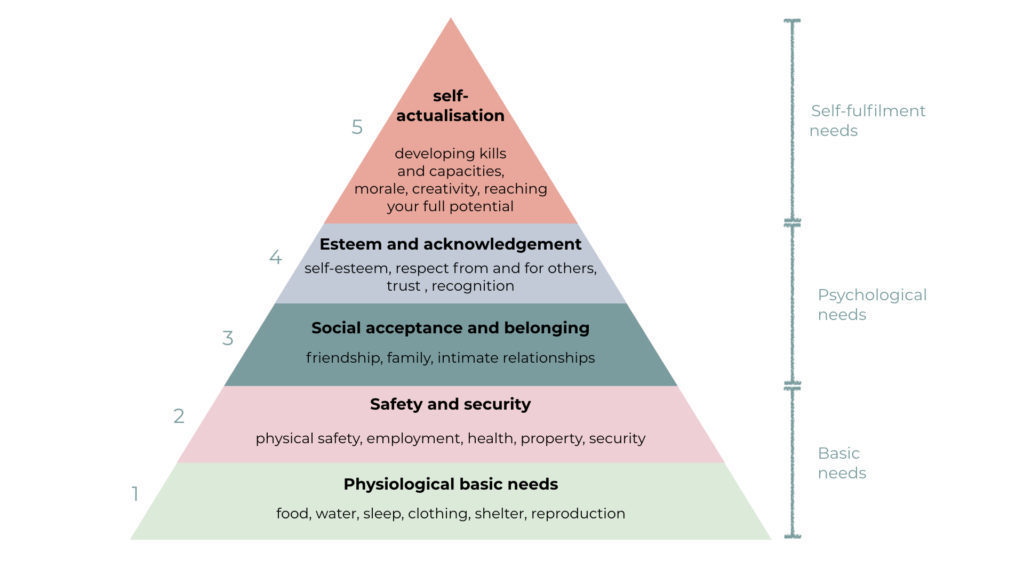Every human being has needs. A need is something you desire or something you cannot live without. We also call this individual or personal needs. Needs form the basis of your existence, because they give you a sense of direction in what you want and need, and therefore can work as a motivation. When your needs are fulfilled, positive feelings can arise. On the other hand, when your needs are not fulfilled or disturbed, you can experience negative feelings. Being aware of your fulfilled and unfulfilled needs and the associated feelings, can give you insight into what you need and desire.
The pyramid of Maslow

In the 60’s the American psychologist Abraham Maslow developed the hierarchy of needs. This theory stated that every person goes through a certain needs structure, the so called pyramid of Maslow (see illustration above here). First, you fulfill your basic needs (lower part of the pyramid), before you can fulfill the more luxurious and less urgent needs. When you fulfill the needs of the lower parts of the pyramid, you can go to self-actualization and find new ways to remain content and grow to psychological health. Daniel Pink supports in his book “drive” the theory of Maslow by stating that the secret of performing better, motivation and more satisfaction lies in the human needs: autonomy (choosing what you do), mastery (learning and developing skills) and meaning ( belonging to a society).
Moving along the pyramid
The pyramid might be a little outdated since the society looks a whole lot different these days, but the basic principles are this applicable. You move along the pyramid mostly layer by layer, but this does not mean that someone who has a chronic disease does not seek creativity or personal development. It especially means that when you need a lower layer falls away or disappears, you probably want to fix this first and seek balance, before you can continue in the higher layers, like developing yourself.
What do you need?
Being aware of the pyramid can help you gain insight into your needs, which are fulfilled and what you need to fulfill. Do not interpret the pyramid as a static fact, but as something you can tailor to you as a person. Below you will find a short explanation of the different layers of the pyramid and a tip on how to approach this in NiceDay!
The layers of the pyramid (from the bottom to the top)
Layer 1: Physiological basic needs
When your basic needs are like food, water, clothing and shelter are fulfilled, you can move onto layer 2. When you feel good physically, the chance is higher you will perform better. For example, when you don’t have a shelter, it is difficult to feel safe and secure (layer 2).
Layer 2: Safety and security
This entails physical safety, employment, good health and property. To function properly it is important to have a safe surrounding. When you have financial problems or a reorganisation at work, these needs can get out of balance.
Layer 3: Social acceptance and belonging
This means friendship, family, intimate relationships, togetherness and love. Good social contacts contribute to your happiness and joy in life. When you have less supportive relationships or a relationship ends, your attention, that might have been in the higher layers, automatically shifts to this layer and resolve this. Your creativity or training of new skills (layer 5) have to wait a little while.
Layer 4: Esteem and acknowledgement
Once you enter this layer, it is probable your basic needs are fulfilled, you feel safe and secure and you have a social network to share this with. Now you are seeking recognition, appreciation and respect of yourself and of others. Needs that belong in this layer are self-esteem, respect from and for others, trust, status, reputation and recognition. These elements give you the feeling that you matter and are of meaning in the eyes of your surrounding.
Layer 5: Self-actualisation
This means striving to develop your own skills and capacities. Moral, creativity and spontaneity also fall in this category. People continuously have the urge to develop themselves and learn new things, but you can do this best when the needs from the lower parts of the pyramid are fulfilled. For example, when you get hungry, you will probably eat first before continuing with you development. And when something bad happens in your social network, you will probably help them first.
Layer 6: Transcendental needs
This 6th layer was added by Maslow in a later stage and is therefore lacking in the illustration. Self transcendence literally means transcending yourself and go beyond the ordinary. It is a state of higher consciousness. People in this layer see themselves as a part of a large universe, are aware of a collective consciousness and see the importance of a common need. According to Maslow, meditation and mindfulness are ways for an individual to reach this layer.
Which of your needs are fulfilled?
“You start by serving your own needs”
NiceDay actions
Write down in your NiceDay journal what needs you have, which are fulfilled and which are unfulfilled. Where do you see something to gain, and what do you need to achieve this?











